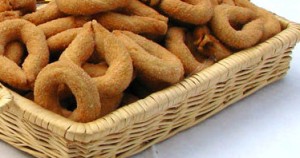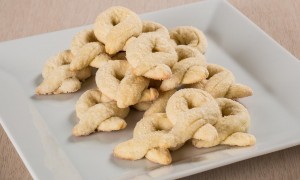TorcettiTorcetti
CARATTERISTICHE
Il torcetto è un prodotto di pasticceria secca a lievitazione naturale, costituito da un bastoncino di pasta, ricoperto di zucchero, e ripiegato ove le due estremità si uniscono assumendo una forma ovale, allungata, a goccia
ZONA DI PRODUZIONE
Alcuni li attribuiscono alle valli Biellesi, dove qualche decennio fa, si sentiva dire quanto erano buoni certi Torcetti del Piazzo (Bi).
Molto noti sono anche i Torcetti di Saint-Vincent (Valle d’Aosta), resi celebri dalla ghiottoneria della regina Margherita.
Senza dimenticarci di Aglié (To), dove è ben radicata la tradizione di festeggiare questo buon biscotto con la “sagra del torcetto”…
In ogni caso, oggi si fanno torcetti un po’ in tutto il Piemonte, al punto che possono essere considerati fra i biscotti più rappresentativi della regione.
STORIA
I “torchietti”, come venivano chiamati nel ‘700 per la loro forma attorcigliata, erano già descritti nel libro “Confetturiere Piemontese” edito nel 1790. Nel “Trattato di cucina e pasticceria moderna” del 1854 Giovanni Vialardi, aiutante capocuoco dei re Carlo Alberto e Vittorio Emanuele II, descrive tre ricette di torchietti, partendo da altrettanti tipi di impasto. Una di queste è pressoché simile all’attuale; la differenza più evidente sta nell’utilizzo del lievito naturale al posto di quello di birra impiegato ai giorni nostri. Sandro Doglio, nel suo “Dizionario di gastronomia del Piemonte”, dopo un’attenta ricerca bibliografica cita Lanzo come probabile paese di origine del torcetto. Tradizionalmente i torcetti sono nati come dolci a base di pasta di pane, passati nello zucchero o nel miele e preparati nei forni comuni a legna dei paesi, nei quali un tempo tutte le famiglie cuocevano insieme il pane. Generalmente i torcetti venivano posti in cottura sulla bocca del forno, in attesa che questo fosse sufficientemente caldo per infornare il pane. Con il passare del tempo il prodotto subì una trasformazione: dagli iniziali grossi bastoncini di pane dolce, dal 1800 in poi il torcetto diventò un vero prodotto di pasticceria secca.
La dimensione dei torcetti si ridusse di circa la metà, la consistenza della pasta si fece più leggera anche grazie alla farina meno grezza, al lievito e, soprattutto, all’introduzione del burro. Si modificò anche il modo di consumare i torcetti. Dapprima essi erano destinati solo ai bambini (nelle rare occasioni che essi avevano, un tempo, di mangiare dolci), poi si passò a presentarli a fine pasto nelle ricorrenze familiari (battesimi, matrimoni, ecc.) a volte accompagnati con panna montana (fioca) spruzzata di caffè d’orzo macinato o con lo zabaione (successivamente).
Ricetta
Ecco la ricetta dei torcetti biellesi:
Ingredienti
farina 500 gr
burro a cubetti 200 gr
zucchero 150 gr
lievito di birra 5 gr
sale
Procedimento
Mettere il lievito in due cucchiai di acqua tiepida e lasciarlo sciogliere.
Disporre la farina a corona con un pizzico di sale, due cucchiai di zucchero e nel centro mettere il lievito e aggiungere 250 cc di acqua. Quindi impastare il tutto fino ad ottenere un impasto liscio e omogeneo.
Far lievitare l’impasto per i torcetti fino a quando non sarà raddoppiato di volume (circa un’ora).
Lavorare i cubetti di burro per ammorbidirli, quindi impastare il burro con il composto lievitato. Ripetere la lievitazione per un’altra ora circa.
Impastare brevemente l’impasto e formare, facendola passare sotto il palmo delle mani, dei bastoncini del diametro di un centimetro circa e della lunghezza di una decina di centimetri.
Passarli nello zucchero rimasto e accavallare le punte schiacciandole in modo da dare loro la classica forma a goccia.
Disporre i torcetti su di una teglia precedentemente foderata con carta da forno, infornarli a 200°C per un quarto d’ora circa.
La conservabilità dei torcetti varia a seconda dei luoghi in cui vengono immagazzinati e confezionati e può arrivare, nelle migliori condizioni, a circa sei mesi.
Il prodotto è venduto sciolto o confezionato in sacchetti personalizzati.
Fonte: cucina.corriere.it
CHARACTERISTICS
The Torcetto is a naturally leavened dried confectionery product, consisting of a stick of paste, coated with sugar, and folded when the two ends are joined into an oval shape, as an elongated teardrop.
PRODUCTION AREA
Some attribute them to the valleys of Biella, where a few decades ago, he felt to say how much were good some Torcetti of Piazzo (Bi). Very famous also are the Torcetti of Saint-Vincent (Aosta), made famous by the gluttony of Queen Margherita. Without forgetting Aglié (To), where it is well rooted tradition of celebrating this good cookie with the “festival of Torcetto” … In any case, today there are torcetti a bit all over the Piedmont, to the point that they can be considered among the most representative cookies of the region.
HISTORY
The “torchietti” as they were called in ‘700 for their twisted shape, were already described in the book “Confetturiere Piemontese” published in 1790. In the “Treaty of cooking and modern pastry” of 1854 Giovanni Vialardi, assistant chef of King Carlo Alberto and Vittorio Emanuele II, describes three recipes of torchietti, starting from as many types of dough. One of these is almost similar to the current; the most obvious difference is the use of natural yeast instead of the beer yeast used nowadays. Sandro Doglio, in his “Dictionary of gastronomy of Piedmont”, after a thorough literature review cites Lanzo as likely village of origin of torcetto. Traditionally torcetti were born as cookies made of bread dough, passed in sugar or honey and prepared in wood-burning ovens common in the countries in which time all the families used to bake bread together. Generally torcetti were placed in the mouth of the baking oven, until this was hot enough to bake bread. With the passage of time the product underwent a transformation: from the initial big sticks sweet bread, from 1800 onwards the torcetto became a true product of dry pastry.
The size of the torcetti was reduced by about half, the consistency of the paste is made lighter thanks to less raw flour, to the yeast, and especially the introduction of the butter. It also altered the way to consume torcetti. At first they were intended only to children (on the rare occasions that they had at one time to eat sweets), then went on to present after the meal and to family gatherings (baptisms, weddings, etc.), Sometimes accompanied with whipped cream sprinkled of ground barley coffee or with eggnog.
Recipe
Here is the recipe of torcetti from Biella:
Ingredients
flour 500g
butter into cubes 200 gr
sugar 150g
beer yeast 5 g
salt
Method
Put the yeast in two tablespoons of warm water and let it melt.
Place the flour in crown with a pinch of salt, two tablespoons of sugar in the center and put the yeast and add 250 ml of water. Then knead until dough is smooth and homogeneous.
Let leaven the dough for torcetti until doubled in volume (about one hour).
Working cubes of butter to soften, then knead the butter and the yeast mixture. Repeat the leavening for another hour.
Knead the dough briefly and form by passing it under the palm of the hands, sticks with a diameter of one centimeter and a length of about ten centimeters.
Pass them in the remaining sugar and cross the ends crushing them to give them the classic teardrop shape.
Arrange torcetti on a baking pan lined with parchment paper, bake at 200 ° C for about fifteen minutes.
The shelf life of torcetti varies according to the places where they are stored and packaged and can arrive in the best conditions, in about six months.
The product is sold loose or packaged in custom bags.
Source: cucina.corriere.it







Leave a comment